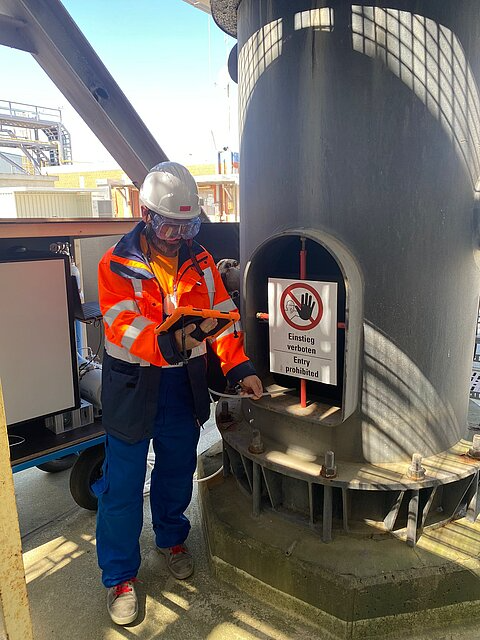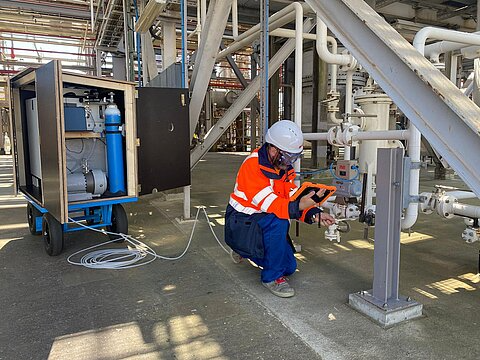Most toxic industrial compounds are somewhat volatile and may produce airborne hazardous emissions, posing additional risks for workers and the public. How toxic a compound is correlates directly with its occupational exposure limit (OEL), with more hazardous substances having lower OELs. Trichloropropane, for example, has an OEL of 5 ppb, highlighting the need for extremely sensitive detection strategies.
Multiple important applications underscore the necessity for effective detection and monitoring:
- Leak testing: Pipelines, usually comprising many flanges, necessitate thorough leak testing. Although initial leak testing is critical, continuous monitoring is optimal, as factors such as gasket failure, corrosion, mechanical damage, and thermal or mechanical cycling can lead to leaks as time passes.
- Clearance testing: Parts should be tested before servicing to verify the absence of harmful compounds, ensuring safe handling.
- Dismantling industrial complexes: While dismantling industrial facilities, residual toxic substances are released, putting workers and the environment at a significant health risk. Continuous monitoring of hazardous emissions is critical for ensuring safety throughout the process.
Classical offline sampling followed by gas chromatography/mass spectrometry (GC-MS) analysis in a lab can cover numerous compounds with low detection limits. GC-MS, however, is labor-intensive and time-consuming, and the results are only available a day later, delaying the feedback required for rapid decision-making. Situations can also rapidly change and leaks can happen at any time, putting workers at considerable risk.
Real-time monitoring provides instantaneous feedback and facilitates fast intervention to guard worker safety and prevent environmental contamination. No portable analyzers are currently available, however, that can reliably identify many hazardous compounds at low concentrations.
Optical approaches such as nondispersive infrared and cavity ring-down can only be used for small molecules like methane (CH4), hydrogen chloride (HCl), and hydrogen sulfide (H2S).
Mass spectrometric (MS) approaches carry many advantages, like the ability to identify a broad range of compounds at low concentrations. However, quadrupole-based MS systems usually have low mass resolution, limiting their specificity and potentially taking up to a minute to conclude a full scan.
This constraint is resolved by proton-transfer-reaction time-of-flight MS (PTR-TOF-MS), which unites high mass resolution and real-time detection, enabling the identification of various compounds at sub-ppb levels.
It is possible to complete a full spectral scan with PTR-TOF-MS in under one second while preserving sub-ppb detection limits. Despite these capabilities, MS-based systems have conventionally been stationary, lab-based tools principally built for scientific research.
IONICON has recently developed its PTR-TOF systems for industrial use, highlighting their high stability, reliability, and ease of use. In a project between Olin and IONICON, the PTR-TOF system has been advanced further for real-time detection of hazardous volatile compounds in mobile environments and has been deployed and tested in the field.

Figure 1. Operator checking a manhole for emissions using the live data streamed to a tablet display from the mobile PTR-TOF instrument. Image Credit: Olin
Methods
IONICON has advanced its robust PTR-TOF system, a PTR-TOF 1000. This system detects hazardous compounds with a 100-meter-long sampling line alongside an extra pump to preserve rapid sample transfer from far-off locations to the analyzer.
IONICON’s Automated Measurement and Evaluation (AME) software was specifically trained to identify a predefined list of hazardous compounds yet additionally tracks all compounds present in the air, such as those that have not been predefined on the list.
To improve the system’s mobility and adaptability even further, the PTR-TOF was set up atop a mobile platform together with Olin. This setup enabled the device to be positioned near the sampling sites. Data gathered from the system was then wirelessly streamed to a tablet.
Results
The system was set up on a simple yet powerful mobile platform, which made it possible to deploy the PTR-TOF system within the sampling radius of different points. The long sampling line, reinforced by an extra pump, facilitated the rapid transfer of gas samples, generating results almost in real time.
Even elevated concentrations of “sticky” compounds, like phenol, were soon cleared out of the system, guaranteeing dependable and continuous monitoring without delays stemming from residual contamination.
The real-time capability facilitated the probing of certain points and “sniffing around,” which aided in more accurately pinning down emission sources, like leaks. Data streamed to the tablet allowed for direct feedback, permitting the operator to calibrate the sampling location in real time.
The handcart utilized as a mobile platform for this presentation proved effective, with its soft wheels providing adequate shock absorption throughout transport. The PTR-TOF showed its robustness and appropriateness for the application.
In the next phase, OLIN aims to use the PTR-TOF with a multi-channel sampling unit on an electric vehicle, improving mobility and guaranteeing constant power to the system.

Figure 2. Operator locating the source of an emission using the live data streamed to mobile display. On the left, the simple but effective mobile PTR-TOF platform can be seen. Image Credit: Olin
Conclusion
Real-time monitoring technology like PTR-TOF is essential for identifying numerous hazardous compounds at low concentrations. It facilitates rapid assessment and immediate feedback, greatly speeding up the process compared to conventional approaches. This capability is particularly important for industrial applications, where timely detection is critical for safety.
Contrasting traditional leak testing, where pipelines are pressurized with a probe gas such as helium—necessitating a process interruption—online leak testing enables continuous, in-process monitoring. Leaks can be identified by “sniffing” the process compounds directly without stopping operations.
The versatility of IONICON’s AME software, which operates in several modes and tracks a broad range of compounds, improves the system’s specificity for hazardous substances and reduces the occurrence of false positives.
As a PTR-TOF spectrum captures the entire spectrum of identified compounds, the system can be easily calibrated to track novel or emerging hazards as well.
More technical enhancements, like integrating the PTR-TOF with an electric vehicle platform, aim to improve mobility and facilitate continuous power supply throughout field operations. This sophisticated solution is important for protecting workers and the public alike in settings where hazardous compounds are present while reducing interruptions to industrial processes.

This information has been sourced, reviewed, and adapted from materials provided by IONICON Analytik.
For more information on this source, please visit IONICON Analytik.